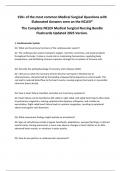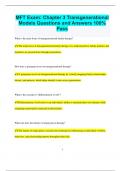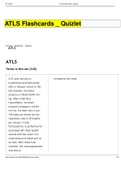150+ of the most common Medical Surgical Questions with
Elaborated Answers seen on the NCLEX®
The Complete NCLEX Medical Surgical Nursing Bundle
Flashcards Updated 2025 Version.
1. Cardiovascular System
Q1: What are the primary functions of the cardiovascular system?
A1: The cardiovascular system transports oxygen, nutrients, hormones, and waste products
throughout the body. It plays a crucial role in maintaining homeostasis, regulating body
temperature, and facilitating immune responses through the circulation of immune cells.
Q2: Describe the pathophysiology of coronary artery disease (CAD).
A2: CAD occurs when the coronary arteries become narrowed or blocked due to
atherosclerosis, characterized by the buildup of plaque (fatty deposits) on arterial walls. This
can lead to reduced blood flow to the heart muscle, causing angina (chest pain) or myocardial
infarction (heart attack).
Q3: How is heart failure classified, and what are its primary symptoms?
A3: Heart failure can be classified as left-sided or right-sided. Left-sided heart failure often leads
to pulmonary congestion, causing symptoms like dyspnea, orthopnea, and crackles on
auscultation. Right-sided heart failure leads to systemic congestion, resulting in peripheral
edema and jugular vein distension.
Q4: What assessment findings might indicate an arrhythmia?
A4: Signs of arrhythmias include irregular heartbeats, palpitations, syncope (fainting), or altered
mental status. During assessment, a nurse may observe changes in heart rhythm on an EKG,
abnormal heart sounds, or variations in pulse quality.
Q5: How do you perform a cardiovascular assessment?
,A5: A cardiovascular assessment involves taking vital signs (heart rate, blood pressure),
auscultating heart sounds, palpating pulses, inspecting for edema, and evaluating capillary refill.
An EKG may also be conducted to assess electrical activity in the heart.
Q6: What nursing interventions are appropriate for a patient with heart failure?
A6: Interventions include monitoring vital signs, administering prescribed diuretics to reduce
fluid overload, educating the patient on dietary sodium restriction, and encouraging daily
weights to monitor fluid status. Patient education about recognizing signs of exacerbation is
crucial.
Q7: Describe the use of diuretics in managing hypertension.
A7: Diuretics help lower blood pressure by promoting the excretion of sodium and water, which
reduces blood volume. Common diuretics include thiazides and loop diuretics. Monitoring
electrolyte levels, especially potassium, is essential due to potential side effects.
Q8: What lifestyle modifications can help manage coronary artery disease?
A8: Lifestyle modifications include adopting a heart-healthy diet (low in saturated fats,
cholesterol, and sodium), regular exercise, quitting smoking, managing stress, and adhering to
prescribed medications. These changes can improve overall cardiovascular health.
Q9: Explain the role of beta-blockers in cardiovascular management.
A9: Beta-blockers reduce heart rate and myocardial oxygen demand by blocking the effects of
adrenaline. They are often prescribed for hypertension, heart failure, and after a myocardial
infarction. Patients should be monitored for bradycardia and hypotension.
Q10: What are the signs and symptoms of myocardial infarction (MI)?
A10: Symptoms of MI may include chest pain or discomfort (often described as pressure or
squeezing), radiating pain to the arms, back, neck, or jaw, shortness of breath, nausea,
sweating, and anxiety. Immediate medical attention is critical.
Q11: How is blood pressure classified according to the American Heart Association?
,A11: Blood pressure is classified as normal (less than 120/80 mmHg), elevated (120-129/<80
mmHg), stage 1 hypertension (130-139/80-89 mmHg), and stage 2 hypertension (140/90 mmHg
or higher). Each category guides management and treatment decisions.
Q12: What is the significance of the ejection fraction in heart failure?
A12: Ejection fraction measures the percentage of blood leaving the heart each time it
contracts. A normal ejection fraction is 55% or higher. In heart failure, reduced ejection fraction
indicates systolic dysfunction and correlates with prognosis and treatment options.
Q13: What dietary modifications should patients with heart disease consider?
A13: Patients should limit saturated fats, trans fats, and cholesterol intake while increasing
fiber-rich foods like fruits, vegetables, and whole grains. Reducing sodium intake is vital to
managing blood pressure and preventing fluid retention.
Q14: Explain the importance of patient education on anticoagulant therapy.
A14: Patient education is crucial for ensuring adherence to anticoagulant therapy,
understanding the risks of bleeding, the importance of regular blood tests (e.g., INR monitoring
for warfarin), and recognizing signs of bleeding or thromboembolism.
Q15: What is the difference between stable and unstable angina?
A15: Stable angina occurs with predictable patterns of activity and is relieved by rest or
nitroglycerin. Unstable angina is unpredictable, may occur at rest, and represents a higher risk
of myocardial infarction. Immediate medical evaluation is necessary for unstable angina.
Q16: How can a nurse effectively monitor for complications after cardiac surgery?
A16: Postoperative monitoring includes assessing vital signs, monitoring for signs of bleeding or
infection, evaluating heart rhythm, and observing for signs of heart failure. Early detection of
complications can significantly improve outcomes.
Q17: What role does the nurse play in the care of a patient undergoing cardiac catheterization?
, A17: The nurse prepares the patient by explaining the procedure, obtaining consent,
monitoring vital signs and sedation levels, and assessing for complications such as bleeding or
arrhythmias post-procedure. Patient education on recovery and potential complications is also
vital.
Q18: How do calcium channel blockers work in managing cardiovascular conditions?
A18: Calcium channel blockers relax blood vessels and reduce heart rate by inhibiting calcium
influx into cardiac and smooth muscle cells. They are effective in treating hypertension, angina,
and certain arrhythmias.
Q19: What are the key components of a cardiac rehabilitation program?
A19: Key components include personalized exercise plans, nutritional counseling, education on
heart-healthy living, and psychosocial support. The program aims to improve functional
capacity, reduce risk factors, and enhance quality of life.
Q20: Why is early recognition of heart failure symptoms crucial?
A20: Early recognition allows for timely intervention, which can prevent hospitalizations and
improve patient outcomes. Educating patients on recognizing symptoms such as sudden weight
gain, increased shortness of breath, and fatigue is essential for effective management.
2. Respiratory System
Q21: What are the primary functions of the respiratory system?
A21: The respiratory system facilitates gas exchange, supplying oxygen to the bloodstream and
removing carbon dioxide. It also plays a role in regulating blood pH, protecting the airway from
pathogens, and enabling vocalization.
Q22: Describe the mechanics of breathing.
A22: Breathing involves two phases: inhalation (diaphragm and intercostal muscles contract,
expanding the thoracic cavity and decreasing pressure) and exhalation (muscles relax, reducing
thoracic cavity size and increasing pressure). This creates a pressure gradient that facilitates
airflow.






